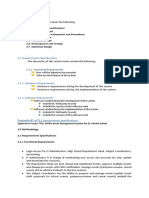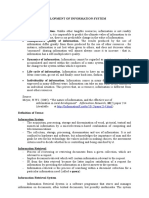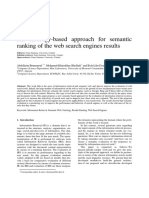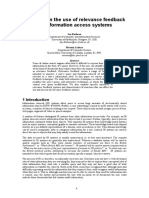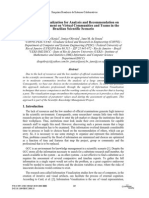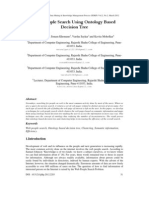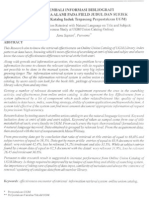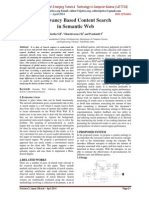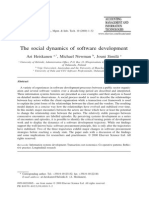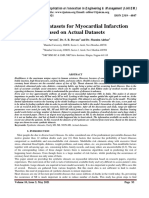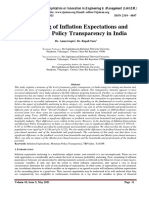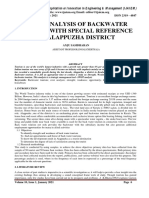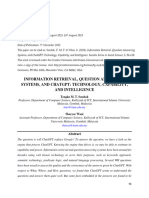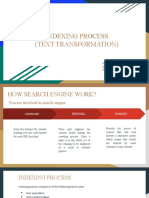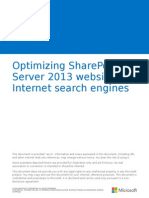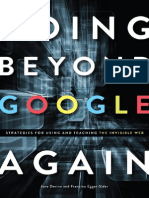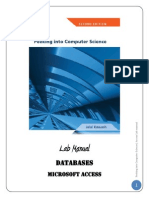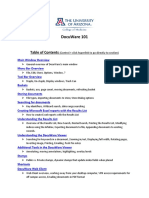0 ratings0% found this document useful (0 votes)
23 viewsInformation Research in Indexed Medical Video Conferences Databases
Information Research in Indexed Medical Video Conferences Databases
International Journal of Emerging Trends & Technology in Computer Science (IJETTCS)
Web Site: www.ijettcs.org Email: editor@ijettcs.org
Volume 3, Issue 4 July-August 2014 ISSN 2278-6856
Copyright:
© All Rights Reserved
Available Formats
Download as PDF, TXT or read online from Scribd
Information Research in Indexed Medical Video Conferences Databases
Information Research in Indexed Medical Video Conferences Databases
0 ratings0% found this document useful (0 votes)
23 views7 pagesInternational Journal of Emerging Trends & Technology in Computer Science (IJETTCS)
Web Site: www.ijettcs.org Email: editor@ijettcs.org
Volume 3, Issue 4 July-August 2014 ISSN 2278-6856
Original Title
IJETTCS-2014-08-18-110
Copyright
© © All Rights Reserved
Available Formats
PDF, TXT or read online from Scribd
Share this document
Did you find this document useful?
Is this content inappropriate?
International Journal of Emerging Trends & Technology in Computer Science (IJETTCS)
Web Site: www.ijettcs.org Email: editor@ijettcs.org
Volume 3, Issue 4 July-August 2014 ISSN 2278-6856
Copyright:
© All Rights Reserved
Available Formats
Download as PDF, TXT or read online from Scribd
Download as pdf or txt
0 ratings0% found this document useful (0 votes)
23 views7 pagesInformation Research in Indexed Medical Video Conferences Databases
Information Research in Indexed Medical Video Conferences Databases
International Journal of Emerging Trends & Technology in Computer Science (IJETTCS)
Web Site: www.ijettcs.org Email: editor@ijettcs.org
Volume 3, Issue 4 July-August 2014 ISSN 2278-6856
Copyright:
© All Rights Reserved
Available Formats
Download as PDF, TXT or read online from Scribd
Download as pdf or txt
You are on page 1of 7
International Journal of EmergingTrends & Technology in Computer Science(IJETTCS)
Web Site: www.ijettcs.org Email: editor@ijettcs.org, editorijettcs@gmail.com
Volume 3, Issue 4, July-August 2014 ISSN 2278-6856
Volume 3 Issue 4 July-August, 2014 Page 226
Abstract
The performance of an information retrieval system (IRS) may
be degraded in terms of accuracy due to the difficulty for users
to express their information needs precisely. Reformulation or
query expansion is one of the answers to this problem within
the IRS. In this paper, we propose a new method of
reformulating conceptual queries seeking, from the initial user
query and domain ontology, a set of concepts maximizing the
performance of SRI. These are evaluated in an original way,
using indicators for which a formalization is proposed. Then
we calculate the matching score between the query and
documents reformulated medical videoconferences to give the
user the most relevant document
Keywords : Query, reformulation query, matching document
query, relevancy score, similarity calculation, calculation of
correspondence, ontology, user profile, information retrieval,
medical videoconferencing.
1. INTRODUCTION
The main task of SRI is to select from a collection of
documents those which are able to respond to the user's
needs of information. To reduce the 'silence' (a proportion
of relevant documents among those not found) and the
'noise' (proportion of irrelevant documents among those
returned), three processes are generally implemented in
SRI: first, an analysis process that aims at reprocessing the
documents of the corpus, second, an indexing process that
provides a compact and semantic representation of
documents and queries using concepts and semantic
relations between these concepts, and finally, a search
process consisting of two main tasks. In the first step, this
process supports the generation of a new application using
external resources such as ontologies, users profil and the
initial query. In the second step, it calculates the
correspondence (matching) between the reformulated
query and the documents of the corpus to satisfy the
users needs. It is generally presented as in Figure 1.
2. QUERY REFORMULATION
The user sometimes faces a difficult situation. He is unable
to find the exact words to express the needed information.
So, if not the majority of the documents found may interest
the user less than others. In addition, some queries are
short and, therefore, not semantically rich, so that the IRS
can return relevant documents. To overcome these
problems, researchers in RI have turned to incorporating
an additional step in the research process which is the
reformulation or expansion of the query. It consists in
changing the users initial query by adding significant
terms and / or re-estimating their weight. Ralalason
proposes a process of querys reformulation in his thesis
[7]. This reformulation can be automatic or manual
depending on whether the system or the user carries it out.
Thus, the query reformulation may particularly intervene
at two levels
during the initial search, if no document is found, the
system performs the reformulation;
if the reader is not satisfied with the systems response
after an initial search, he may reformulate the query.
The reformulation of the query can be based on the users
profile and/or external resources. In our work, we propose
a reformulation of queries guided by an external resource.
It is to rewrite the query of the user by taking into account
synonymy and metonymy relations presented in the
external resources. So, the query is enhanced by terms
semantically close to the original ones. These semantically
- similar terms are issued from domain ontologies in order
to search for documents in a medical corpus. Similarly, we
rely on the users profile to reformulate queries. We use a
progressive mechanism to categorize users by building a
static contextual elements base used to reformulate the
initial query to produce a new one which reflects better the
users needs.
Information Research in indexed medical video
conferences databases
Yengui Ameni
1
, Mahmoud Neji
2
1
University of Sfax, Tunisia, Higher Institute of Biotechnology
240 Which occurred freedom, Sakiet Ezzit, 3021, Sfax Tunisia
2
University of Sfax, Tunisia, Faculty of Economics and Management
FSEG PB:1088, 3018 Sfax Tunisia
International Journal of EmergingTrends & Technology in Computer Science(IJETTCS)
Web Site: www.ijettcs.org Email: editor@ijettcs.org, editorijettcs@gmail.com
Volume 3, Issue 4, July-August 2014 ISSN 2278-6856
Volume 3 Issue 4 July-August, 2014 Page 227
Figure 1 Research process
The structure of the reformulation step, its constituent
tasks as well as the interactions between them are
illustrated in Figure 2.
Figure 2 Reformulation of the users query
The formulated query is matched with the documents
indices. These indices having a sufficient "similarity" to
the
Table 1 : Examples of query modification
The reformulation of queries occurs in three phases: (i)
capture of the static context, (ii) identification of the
concepts that match the users needs, (iii) the composition
of these terms in order to formulate the query. Generally
speaking, queries as those formulated by users query are
considered to be relevant. Below, we present an example of
the query modification. according to the cases target: (i)
concepts or terms related to the field of the query:
migraine, migraine aura headaches; (ii) elements
presented in various parts of a videoconference (media
type). To properly formulate the query, we propose to use
external knowledge such as domain ontologies. To achieve
this, we use some semantic relations that play a significant
role in the organization of knowledge (causal relation,
definition, ..).
2.1. phase of Capture of the static context
This phase is used to identify a user through a series of
information for his categorization. The user defines the
static context when first using the system. This context is
composed of four categories:
Connection parameter: login, password
Personal characteristics: name, surname, country, ...
Interest and preferences: domain, specialty, ...
Competence: Occupation, education level, ...
This phase is presented in Figure 3.
Figure 3 Phase of the recovery of the users static context
2.2. Reformulation phase
The purpose of this phase is to produce a new query from
the query initially formulated by the user by adding words
from the context of his current research. The user gives his
query using his own terms. The system performs the
extraction of all the terms to be added to produce a new
query. First, these terms are extracted from the base of the
users contexts. Then, we retrieve the specific concepts
from the ontology. In
case the concept C1 is presented as a term in the original
application, it will be expanded by the concept C2 which is
retrieved from the ontology (UMLS, ONTOMENELAS ..).
The extension of the concepts is based on the presence of a
semantic relation between C1 and C2 (synonym or a more
general concept).
This phase shall run in two steps acting on different
aspects of the initial query. These steps are:
Extraction of concepts: we retrieve the query terms
presented in the ontology. Then we search in (go over) the
ontology using these terms as an entry point to extract
concepts that are directly related to each term.
The concepts are retrieved from the ontology in the
following way:
If the concept (C
1
) is present as a term in the initial
query, it will be expanded by the concept (C
2
)
retrieved from the domain ontology.
The choice of (C
2
) follows a navigation of the XML
file describing the ontology.
We seek a semantic link between (C
1
) and (C
2
). This
link may be of type "Synonym", " more general
concept" ...
In this case, the role of user is passive because it does not
intervene in the selection of the concepts. The calculation
International Journal of EmergingTrends & Technology in Computer Science(IJETTCS)
Web Site: www.ijettcs.org Email: editor@ijettcs.org, editorijettcs@gmail.com
Volume 3, Issue 4, July-August 2014 ISSN 2278-6856
Volume 3 Issue 4 July-August, 2014 Page 228
time is too high for a large ontology. In the context of a
heuristic approach, it is reasonable to test only the
concepts that are semantically close to the concepts
indexing the documents. If is a measure
of semantic proximity between CX and CY, two concepts
of , we construct C() in the following way:
(1)
C () is constructed by identifying, for each concept those ,
the semantically-close concepts that should be considered
[11].
Reformulation query: the integration in the phase of
querys reformulation consists of arguing the initial query
by concepts issued from the stage of concepts extraction
and terms issued from the users profile. The new query is
consequently transmitted to the corresponding step (section
II). This query will be presented in the form of a
conceptual graph. The reformulation process is
summarized in Figure 4 shown below:
Figure 4 Architecture of the reformulation process.
The algorithm of our reformulation approach is the
following
Algorithm 1 : Reformulation
Reformulation Algorithm
Input :
Q : Users query
O : Ontology
P : a users profile
Output :
Q : reformulated query
Variables :
Lc : list of concepts
Lt : list of terms
Begin
Pretreatment of the query ; /* Extraction of terms*/
If (exist already (Lt) =true) then
Lc Lt ;
else
Lc Extraction (Lt) ;
End if
Q Q +Lc
End
approach uses an algorithm of extraction that identifies the
concepts for each term. This algorithm is the following:
Algorithm 2 : Extraction
Extraction Algorithm
Input:
Lt : List of terms
Lco : List of the ontologys concepts
Iu : Interest of the user
Cu : competence of the user
Output :
Lc : List of concepts
Variables :
t : Term
c : Concept
Begin
For each term do
Identify the concepts related to t
case Iu of
Case 1 : Lu is not medicine :
If t belongs to Lco then
Add (c(t)) to Lc /* c is the identified concept */
End if
Case2 : Iu is medicine :
Case Cu do
Case1 : Cu is expert or doctor :
if t belongs to Lco then
Add(c) to Lc /* c is the identified concept*/
End if
Case2 : Cu is student :
If t belongs to Lco then
Add (c(t)) to Lc /* c is the identified concept */
End if
End case
End case
End for
End
3. MATCHING DOCUMENT-QUERY
The comparison between the document and the query
enables to calculate a measure called relevance system
supposed to represent the relevance of the document in
comparison with the query. This value is calculated using
a similarity function denoted RSV (Q, D) (Retrieval Status
Value), where Q is a query and D is a document. This
measure takes into account the weight of terms in the
documents. In general, matching the query-document and
the indexing model allows characterizing and identifying a
model of information retrieval. The order in which the
returned documents expected to respond to the query is
important. Indeed, the user, in general, simply considers
the first returned documents (the first 10 or 20). If the
required documents are not in this range, the user will
consider SRI as bad comparing to his query. Many
International Journal of EmergingTrends & Technology in Computer Science(IJETTCS)
Web Site: www.ijettcs.org Email: editor@ijettcs.org, editorijettcs@gmail.com
Volume 3, Issue 4, July-August 2014 ISSN 2278-6856
Volume 3 Issue 4 July-August, 2014 Page 229
matching models have been proposed in the literature: The
Boolean model [8], the weighted Boolean model [12], The
vector space model, the extended vector model [4], the
probabilistic model [3], the inferential model [2], the
differential Bayesian model [13] and language models [6].
In order to take into account the semantics when
evaluating, and therefore when generating the new
classification and its comparison with the default
classifications of the SRI, Bouramoul associates to each
term in the query all words that are semantically related to
it. The idea is to project the query terms in the ontologys
concepts using both semantic relations "synonymy" and
"hypernonymy" to extract the different meanings of the
query. Thereafter, all retrieved concepts for each term are
used in conjunction with the term itself when weighting
using the calculation module. The objective is to promote a
document that contains words semantically closed to what
the user is looking for, even if those words do not exist in
the query [1]. The concepts found after the reformulation
phase of the request will be presented in the form of GC.
Similarly, in the indexing module of our SRI [14], the
index of each video conferencing is also treated in the form
of a GC. To satisfy the user's need for research, there are
two steps to be followed:
Search of correspondence: this step can be done using
two methods. First, we perform a projection of the
querys conceptual graph on the documents
conceptual graph. In case this task does not give a
result, we use, secondly, a similarity function between
concepts.
Calculation of relevance of the documents found.
3.1. Search of correspondence
3.1.1. Projection graph
The formalism of conceptual graph enables to ask and seek
for sub-graphs in a graph using the projection operator
[10]. The latter takes into account the concepts and
relations. The projection of a query graph GRI on a
conceptual graph GAi noted , concludes that
there is a sub-graph GAi that is specific to the graph GRi.
Informally, a conceptual graph GD is a the projection of a
graph GR if each concept GR has a specific concept in
GD. If such a projection exists, then, it has been proven
that the document responds the query (as shown in Figure
5). In [5], it was shown that a search algorithm
corresponding to the projection operator on the conceptual
graph can be implemented very efficiently in terms of
complexity. We propose to use this algorithm. We quantify
the correspondence between a query graph GR and an
indexing graph GD by combining a matching on the
concepts and a matching on the arches.
Figure 5 Operation of projection of GCs
We call an arch a triplet (concept, relation, concept)
linking three nodes - two concepts and a relation- in a
conceptual graph. From where :
(2)
In the formula (2), the frequencies of terms ft and the
inverse frequencies of documents fid are calculated as
follows:
The frequency of the term ft associated with a concept
C in a conceptual graph G is defined as the number of
the concepts G which are specific to the concept C.
The inverse frequency of a document fid associated
with a concept C is based on documents that are
described by C or by a specific concept C.
We use a formula inspired from [9].
(3)
Where
D: the corpus of documents
D: the documents corresponding to C
For an arch, the principle is similar to concepts. Given that
indexation can be a conceptual graph, or a set of unrelated
conceptual graph, we define the matching between a query
graph GR and a set S of an indexing graph GD as the
maximum matching between GR and each graph GD of S:
(4)
3.1.2. Similarity Calculation
In the case where the projection of the query graph on the
indexing graphs does not give a result, we use a measure
of similarity between the conceptual graphs associated to
the query and those associated with the different
documents in the corpus. In our system, we take into
account the various terms that constitute a concept. The
similarity between two concepts is assimilated to the
number of common terms between them. This function is
called Sim. The more common terms two concepts have,
the more they are closer to each other. Firstly, we calculate
International Journal of EmergingTrends & Technology in Computer Science(IJETTCS)
Web Site: www.ijettcs.org Email: editor@ijettcs.org, editorijettcs@gmail.com
Volume 3, Issue 4, July-August 2014 ISSN 2278-6856
Volume 3 Issue 4 July-August, 2014 Page 230
the proximity of a given concept. This proximity is
measured by the ratio between the common terms (between
the two concepts) and all the terms of the concept.
Figure 6 : calcul of similarity
We propose:
CR: a found concept in the query;
Term (CR): the set of existing words in CR;
Term (CR) ={A, B, D, H, M}
CD: a found concept in video-conference;
Term (CD): the set of existing words in CD;
Term (CD) ={A, B, D, G, L}
We call the common terms between the two concepts by
Ancestor.
Ancestor (CR, CD)=Term (CR) Term (CD) ={A,
B, D, H, M} {A, B, D, G, L} ={A, B, D}
The Proximity of concept CR against Ancestor (CR, CD) is
expressed by:
Similarly, we propose the formula of semantic similarity
between concepts:
Sim(CR, CD)=Proximity(CR)* Proximity(CD) (7)
Take the example cited above:
Term(CR) ={A, B, D, H, M}
Term(CD) ={A, B, D, G, L}
Ancestor (CR, CD) ={ A, B, D}
We calculate the similarity of each querys concept with
those documents. This similarity can facilitate
videoconferences having many concepts of the query.
Algorithm 3 : Matching Document- Query
Algorithm of matching Document-query
Input :
R : query
V : Corpus of video-conferences
Output :
Sim(R, D) : value of similarity between R
and D
Variables :
C
R
: Concept of the query
C
D
: Concept of the document
D : Document of the video-conference
Sim
i
: similarity between CR et CD
Begin
/* Calculation of de similarity between
query and document*/
Sim(R, D) 1
For each Document D of the Corpus V do
For each Concept C
D
of D do
Sim
i
Calculate the similarity
between C
D
and C
R
Sim(R, D) Sim(R, D) * Sim
i
End for
Fin For
If Sim(R, D) >similarity threshold then
keep (D)
end if
end
3.2. calculating relevance
In the previous section, we calculated the similarity
between the queries conceptual graphs and the
videoconferences conceptual graph and we assigned to
each videoconference a similarity score. We can get many
documents that correspond to the query. It is necessary to
order them. Only documents that have a non-zero
similarity score will be sorted by decreasing order. The
search module will return either the most relevant concepts
per document, or the set of all relevant concepts sorted by a
decreasing order and grouped by document or the
documents will be sorted in turn by their relevance to the
set of the querys concepts. The relevance score is
calculated by the following formula:
(8)
where:
R is a query;
D is videoconference;
CD Weighting:
Weighting concept in videoconference.
This score helps to promote video-conferences having
many concepts of a query.
Algorithme 4 : Pertinence Document-query
Algorithme of Pertinence Document-query
Input :
R : query
V : Corpus of videoconference
Output :
S : Score of pertinence of a document D /
query
International Journal of EmergingTrends & Technology in Computer Science(IJETTCS)
Web Site: www.ijettcs.org Email: editor@ijettcs.org, editorijettcs@gmail.com
Volume 3, Issue 4, July-August 2014 ISSN 2278-6856
Volume 3 Issue 4 July-August, 2014 Page 231
Variables :
C
R
: Concept of the query
C
D
: Concept of document
D : Document of the videoconference
Sim(R, D) : value of similarity between R
and D
Sim
i
: similarity between CR and CD
Begin
Score(R, D) 1
/* Calculation of the score of pertinence
of a document */
For each Document D of the Corpus V do
For each Concept C
D
of D do
Score(R, D) weighting C
D
* Sim
i
End if
End if
if Score(R, D) >similarity threshold then
keep Score(R, D)
End if
End
3.3. presentation for the user
The results of SRI are generally presented in the form of a
list of links accompanied by a title and a summary
describing the content of each page. Before being
presented to the user, these results should be ordered
according to the relevance score assigned by the
algorithms of each SRI. In our approach, and to respect
this principle typically used to display the results of a
search, the task of presentation supports the display part
once the results are processed. More precisely, this task
presents an account of a search session as follows:
All results in response to a query, where each result is
represented by a 2-uplet (title, summary).
The semantic relevance score associated with each
result.
All concepts that are associated to each term of the
query.
Figure 7 : illustrates the task of presentation
4. CONCLUSION
The research module consists, mainly, of two steps. The
first is the reformulation of the initial query by exploiting
the semantic relations between concepts using domain
ontology. It is an evolutionary and interactive step. It uses
the initial query to initiate the search in order to re-weight
the terms of the initial query, or to add (or to remove)
other terms to it. The newly- obtained query can correct
the direction of the search for the meaning of the relevant
documents. This reformulation is guided by an external
resource in order to take into account synonymy and
metonymy relations that can be presented without
forgetting the addition of terms semantically similar to the
querys original terms, while taking into account the user
profile. The second step is the matching query-document.
It primarily uses the principle of projection of conceptual
graphs. In case this principle does not make any results,
the matching step is based on a similarity function that
allows to compare the representation of the query to that
of each document. The selected documents will be
classified using the correspondence function and presented
to the user by the 2-uplet (title, summary).
REFERENCES
[1] Bouramoul A., "Recherche dinformation contextuelle et
smantique sur le web", thse de lUniversit MENTOURI
de Constantine Facult des Sciences de lIngnieur,
Dpartement dInformatique, 2011.
[2] Fernandez-Luna J ., Compos L., Huete J ., "Using context
information in structured document retrieval : An approch
based on inuence diagrams", Information Processing and
Management, 40 :829,847, 2004.
[3] Fuhr N., Grossjohann K., "XIRQL : a query language for
information retrieval in XML documents", In In Proceedings
of SIGIR 2001, Toronto, Canada, 2003.
[4] Mass Y., Mandelbrod M., "Component ranking and
automatic query refinement for XML retrieval", In INEX
2004 Workshop Proceedings, pages 73,84. Dagsthul,
Germany, December 2004.
[5] Ounis I., Pasca M., "Relief : Combining expressiveness and
rapidity into a single system", in 21st International ACM
SIGIR, ACM Press, Melbourne, Australia, August 24-28, pp
266-274, 1998.
[6] Ponte J .M., Croft W.B., "A language modelling appraoch to
information retrieval", In Proceedings of the 21st Annual
International ACM SIGIR Conference on Research and
Development in Information Retrieval, pages 40{48, 1998.
[7] Ralalason B., "Reprsentation multi-facette des documents
pour leur accs smantique", Thse de lUniversit
Toulouse III - Paul Sabatier, 2010.
[8] Salton G., "A comparaison between manual and automatic
indexing methods", In Proceedings of J ournal of American
documentation, 1971.
[9] Salton G., "Another look at automatic text-retrieval
systems", Commun. ACM, 29(7) : 648656, 1986.
[10] Sowa J .F., "Conceptual structures: information processing in
mind and machine", Addison-Wesley, 1984.
[11] SY M-F., Ranwez S., Montmain J ., Ranwez V., "OBIRS-
feedback une method de reformulation utilisant une
ontology de domaine", CORIA 2012, pp 135-150,
Borderaux, 21-23 mars 2012
International Journal of EmergingTrends & Technology in Computer Science(IJETTCS)
Web Site: www.ijettcs.org Email: editor@ijettcs.org, editorijettcs@gmail.com
Volume 3, Issue 4, July-August 2014 ISSN 2278-6856
Volume 3 Issue 4 July-August, 2014 Page 232
[12] Trotman A., O'Keefe R. A., "Identifying and ranking
relevant document element". In Proceedings of INEX 2003
Workshop, pages 149,154. Dagsthul, Germany, December
2003.
[13] Turtle H., Croft W.B., "Inference networks for document
retrieval", In A. Bookstein, Y. Chiarmella, G. Salton, and V.
Raghavan, editors, Proceedings of ACM SIGIR, pages 1,24,
1990.
[14] Yengui A., Zwidi A., Neji M., " Research system of
semantic information in medical videoconference based on
conceptual graphs and domain ontologies", in International
J ournal of Management & Information Technology, Vol. 7,
No. 1, ISSN 2278-5612, pages 996-988, November, 2013.
AUTHOR
Ameni Yengui, a teacher at the Higher
Institute of Biotechnology, University of
Sfax, Tunisia, member MIRACL
laboratory and process of preparing a
research thesis entitled "System of
semantic information search for medical databases
videoconferences through the graphs conceptual ". I have 7
papers in international conferences:
(1) "The use of ontologies for the indexing of medical
video-conferencing," ICITeS Tunisia in 2012, (2)
"Audiovisual documents by metadata modeling" ACIT
2011, Riyadh, (3) "The Use of Conceptual Graphs to
Annotate and Semantically to Search the Pedagogic
Videoconferencing "Second Kuwait Conference on e-
Services and e-Systems, 2011, Kuwait University, (4)"
OSVIRA: Ontology-based System for Semantic
Information Retrieval Visio-conference and Annotation ",
IBIMA 2010, Istanbul (5) "A tool of semantic annotation
and research of video-conferences on Conceptual Graphs
founded de" ACIT 2010, Libya (6) "Semantic annotation
of video-conferencing formalism documents" IADIS
CELDA 2009 Rome and an article published in a
newspaper (7) "Research system of semantic information
in medical videoconference based on conceptual graphs
and domain ontologies", in IJMIT, Vol. 7, No. 1,
November 2013.
You might also like
- Chapter 3 Example CapstoneDocument25 pagesChapter 3 Example Capstonedominic56% (9)
- Educational Research: Fundamentals For The Consumer: Sixth EditionDocument37 pagesEducational Research: Fundamentals For The Consumer: Sixth EditionAlbert YazonNo ratings yet
- San Diego County Sheriff's Detention Service Policy and Procedure ManualDocument640 pagesSan Diego County Sheriff's Detention Service Policy and Procedure Manualsilverbull8No ratings yet
- Indexing and Abstracting Reviewer LLEDocument46 pagesIndexing and Abstracting Reviewer LLEYnna Pidor100% (1)
- Project On Business Model of GoogleDocument49 pagesProject On Business Model of GoogleIndira Jha86% (7)
- swj248 PDFDocument8 pagesswj248 PDFakttripathiNo ratings yet
- Ker Ruthven Lalmas PDFDocument53 pagesKer Ruthven Lalmas PDFEbenezer AcheampongNo ratings yet
- Contextual Information Search Based On Domain Using Query ExpansionDocument4 pagesContextual Information Search Based On Domain Using Query ExpansionInternational Journal of Application or Innovation in Engineering & ManagementNo ratings yet
- Unit 1 - Modern Information Retrieval - WWW - Rgpvnotes.inDocument8 pagesUnit 1 - Modern Information Retrieval - WWW - Rgpvnotes.inKunwar ÅyushNo ratings yet
- User Registration System ReportDocument28 pagesUser Registration System ReportBijay TharuNo ratings yet
- The Challenges of E-Appointment Process Modeling IDocument8 pagesThe Challenges of E-Appointment Process Modeling IThiago TallisonNo ratings yet
- Jenna IercDocument6 pagesJenna IercfathalbabNo ratings yet
- Rocchio RelevanceDocument10 pagesRocchio RelevanceOmar El MidaouiNo ratings yet
- Natural Language Processing: Mature Enough For Requirements Documents Analysis?Document12 pagesNatural Language Processing: Mature Enough For Requirements Documents Analysis?halianeNo ratings yet
- Performance Evaluation of Query Processing Techniques in Information RetrievalDocument6 pagesPerformance Evaluation of Query Processing Techniques in Information RetrievalidescitationNo ratings yet
- Saravanan ThesisDocument207 pagesSaravanan ThesisUnimarks Legal Solutions100% (1)
- Web Mining UNIT-II Chapter-01 - 02 - 03Document19 pagesWeb Mining UNIT-II Chapter-01 - 02 - 03Ganesh PandeyNo ratings yet
- Grammar Based Annotation Content Mapping in The Social Page in The Context of Short TextDocument3 pagesGrammar Based Annotation Content Mapping in The Social Page in The Context of Short TextInternational Journal of Application or Innovation in Engineering & ManagementNo ratings yet
- Jonice2008 RedeSocialParaPesquisadoresDocument11 pagesJonice2008 RedeSocialParaPesquisadoresRafael EscalfoniNo ratings yet
- DEXA08final PDFDocument9 pagesDEXA08final PDFVerginaSANo ratings yet
- A New Method For Applicant of Explicit Semantic Analysis and Word Sense Disambiguation in Concept-Based Information RetrievalDocument10 pagesA New Method For Applicant of Explicit Semantic Analysis and Word Sense Disambiguation in Concept-Based Information Retrievaliamtheindiaworld iamtheindiaworldNo ratings yet
- Research Design Chapter 3 ThesisDocument7 pagesResearch Design Chapter 3 Thesisaflpaftaofqtoa100% (1)
- UIC at TREC 2008 Blog TrackDocument11 pagesUIC at TREC 2008 Blog TrackminsandiNo ratings yet
- Multi-Document Extractive Summarization For News Page 1 of 59Document59 pagesMulti-Document Extractive Summarization For News Page 1 of 59athar1988No ratings yet
- NP Tuunenanen A New Perspective On ElicitationDocument18 pagesNP Tuunenanen A New Perspective On ElicitationJose Pardo Vera-TudelaNo ratings yet
- Web People Search Using Ontology Based Decision TreeDocument8 pagesWeb People Search Using Ontology Based Decision TreeLewis TorresNo ratings yet
- 211 PaperDocument5 pages211 PaperacouillaultNo ratings yet
- MIS AssignmentDocument8 pagesMIS AssignmentCharlesTichavavamweNo ratings yet
- (Saad)Document12 pages(Saad)Kokoh RayNo ratings yet
- Analyzing Public Sentiments A ReviewDocument3 pagesAnalyzing Public Sentiments A ReviewEditor IJRITCCNo ratings yet
- Information Retrival List of Experiment - Odd Sem 2024-25Document23 pagesInformation Retrival List of Experiment - Odd Sem 2024-25shrutikadam-cmpnNo ratings yet
- SPC Appointment System - Chapter 3Document6 pagesSPC Appointment System - Chapter 3Namja PyosiNo ratings yet
- Eymethodhas.: Dbollina (Bio - Mg.edu - Au12Document7 pagesEymethodhas.: Dbollina (Bio - Mg.edu - Au12Shina MaliakkalNo ratings yet
- Ej 1087386Document38 pagesEj 1087386Marybel seyerrNo ratings yet
- Dynamic Generation For System Over DatabaseDocument7 pagesDynamic Generation For System Over DatabaseInternational Journal of Application or Innovation in Engineering & ManagementNo ratings yet
- A Mixed Method Approach For Efficient Component Retrieval From A Component RepositoryDocument4 pagesA Mixed Method Approach For Efficient Component Retrieval From A Component RepositoryLiaNaulaAjjahNo ratings yet
- An Agile Process Model For Developing Diagnostic Knowledge SystemsDocument5 pagesAn Agile Process Model For Developing Diagnostic Knowledge SystemsshanthidhivyaNo ratings yet
- IJCER (WWW - Ijceronline.com) International Journal of Computational Engineering ResearchDocument4 pagesIJCER (WWW - Ijceronline.com) International Journal of Computational Engineering ResearchInternational Journal of computational Engineering research (IJCER)No ratings yet
- Id System ThesisDocument5 pagesId System ThesisHelpMeWriteAPaperMurfreesboro100% (2)
- E-Science - Open, Social and Virtual Techno - Claudia KoschtialDocument192 pagesE-Science - Open, Social and Virtual Techno - Claudia KoschtialmaeslorNo ratings yet
- 2020-Theory As A Source of Software RequirementsDocument12 pages2020-Theory As A Source of Software Requirementsless64014No ratings yet
- Situation Analytics - at The Dawn of A New Software Engineering ParadigmDocument14 pagesSituation Analytics - at The Dawn of A New Software Engineering ParadigmJexiaNo ratings yet
- Cabrera-A Protocol of Systems Evaluation-2006Document6 pagesCabrera-A Protocol of Systems Evaluation-2006Zezinho zéNo ratings yet
- Bibliographicinformationretreivalwithnaturallanguageon Titleand Subject: The Effectivenessstudyat UgmunioncatalogonlineDocument13 pagesBibliographicinformationretreivalwithnaturallanguageon Titleand Subject: The Effectivenessstudyat UgmunioncatalogonlineRiezztya WidyaNo ratings yet
- Information RetrievalDocument5 pagesInformation RetrievalNBNo ratings yet
- Relevancy Based Content Search in Semantic WebDocument2 pagesRelevancy Based Content Search in Semantic WebInternational Journal of Application or Innovation in Engineering & ManagementNo ratings yet
- Mix and Match Combining Terms and Operators For Successful Web SearchesDocument17 pagesMix and Match Combining Terms and Operators For Successful Web SearchesOsama AnwarNo ratings yet
- CS6007 - Information RetrievalDocument38 pagesCS6007 - Information RetrievalvNo ratings yet
- How 2 Wrte ReportDocument5 pagesHow 2 Wrte ReportRagu VaranNo ratings yet
- Ranking MetricsDocument15 pagesRanking MetricsrobertsharklasersNo ratings yet
- Dynamic of Software DevelopmentDocument32 pagesDynamic of Software DevelopmentsivainscribdNo ratings yet
- Chapter Two ThesisDocument6 pagesChapter Two ThesissaacidNo ratings yet
- 02 - Klyuev - A Query Expansion Technique Using The EWC SeDocument6 pages02 - Klyuev - A Query Expansion Technique Using The EWC SeparagdaveNo ratings yet
- Coupling and Cohesion in Object-Oriented SystemsDocument34 pagesCoupling and Cohesion in Object-Oriented SystemsMochi ParkNo ratings yet
- IIRS Quiz-1 BitsDocument15 pagesIIRS Quiz-1 BitsSree pujitha DoppalapudiNo ratings yet
- Engineering Problem Statement SampleDocument10 pagesEngineering Problem Statement SampletmamputsiNo ratings yet
- Bees Swarm Optimization Based Approach For Web Information RetrievalDocument8 pagesBees Swarm Optimization Based Approach For Web Information RetrievalMaya NagasakiNo ratings yet
- Bioinqa: Addressing Bottlenecks of Biomedical Domain Through Biomedical Question Answering SystemDocument7 pagesBioinqa: Addressing Bottlenecks of Biomedical Domain Through Biomedical Question Answering Systemsparsh0mittal3572No ratings yet
- QUOTES: Query-Oriented Technical SummarizationDocument17 pagesQUOTES: Query-Oriented Technical SummarizationJuan Ramirez-OrtaNo ratings yet
- Introduction To Information Retrieval SystemsDocument2 pagesIntroduction To Information Retrieval Systemsmohini rawatNo ratings yet
- Irs Unit IIIDocument74 pagesIrs Unit III217r1a05k5No ratings yet
- Data and the American Dream: Contemporary Social Controversies and the American Community SurveyFrom EverandData and the American Dream: Contemporary Social Controversies and the American Community SurveyRating: 1 out of 5 stars1/5 (1)
- Detection of Malicious Web Contents Using Machine and Deep Learning ApproachesDocument6 pagesDetection of Malicious Web Contents Using Machine and Deep Learning ApproachesInternational Journal of Application or Innovation in Engineering & ManagementNo ratings yet
- Study of Customer Experience and Uses of Uber Cab Services in MumbaiDocument12 pagesStudy of Customer Experience and Uses of Uber Cab Services in MumbaiInternational Journal of Application or Innovation in Engineering & ManagementNo ratings yet
- Analysis of Product Reliability Using Failure Mode Effect Critical Analysis (FMECA) - Case StudyDocument6 pagesAnalysis of Product Reliability Using Failure Mode Effect Critical Analysis (FMECA) - Case StudyInternational Journal of Application or Innovation in Engineering & ManagementNo ratings yet
- THE TOPOLOGICAL INDICES AND PHYSICAL PROPERTIES OF n-HEPTANE ISOMERSDocument7 pagesTHE TOPOLOGICAL INDICES AND PHYSICAL PROPERTIES OF n-HEPTANE ISOMERSInternational Journal of Application or Innovation in Engineering & ManagementNo ratings yet
- Study of Customer Experience and Uses of Uber Cab Services in MumbaiDocument12 pagesStudy of Customer Experience and Uses of Uber Cab Services in MumbaiInternational Journal of Application or Innovation in Engineering & ManagementNo ratings yet
- An Importance and Advancement of QSAR Parameters in Modern Drug Design: A ReviewDocument9 pagesAn Importance and Advancement of QSAR Parameters in Modern Drug Design: A ReviewInternational Journal of Application or Innovation in Engineering & ManagementNo ratings yet
- Soil Stabilization of Road by Using Spent WashDocument7 pagesSoil Stabilization of Road by Using Spent WashInternational Journal of Application or Innovation in Engineering & ManagementNo ratings yet
- Staycation As A Marketing Tool For Survival Post Covid-19 in Five Star Hotels in Pune CityDocument10 pagesStaycation As A Marketing Tool For Survival Post Covid-19 in Five Star Hotels in Pune CityInternational Journal of Application or Innovation in Engineering & ManagementNo ratings yet
- A Deep Learning Based Assistant For The Visually ImpairedDocument11 pagesA Deep Learning Based Assistant For The Visually ImpairedInternational Journal of Application or Innovation in Engineering & ManagementNo ratings yet
- Design and Detection of Fruits and Vegetable Spoiled Detetction SystemDocument8 pagesDesign and Detection of Fruits and Vegetable Spoiled Detetction SystemInternational Journal of Application or Innovation in Engineering & ManagementNo ratings yet
- A Comparative Analysis of Two Biggest Upi Paymentapps: Bhim and Google Pay (Tez)Document10 pagesA Comparative Analysis of Two Biggest Upi Paymentapps: Bhim and Google Pay (Tez)International Journal of Application or Innovation in Engineering & ManagementNo ratings yet
- Synthetic Datasets For Myocardial Infarction Based On Actual DatasetsDocument9 pagesSynthetic Datasets For Myocardial Infarction Based On Actual DatasetsInternational Journal of Application or Innovation in Engineering & ManagementNo ratings yet
- The Mexican Innovation System: A System's Dynamics PerspectiveDocument12 pagesThe Mexican Innovation System: A System's Dynamics PerspectiveInternational Journal of Application or Innovation in Engineering & ManagementNo ratings yet
- An Importance and Advancement of QSAR Parameters in Modern Drug Design: A ReviewDocument9 pagesAn Importance and Advancement of QSAR Parameters in Modern Drug Design: A ReviewInternational Journal of Application or Innovation in Engineering & ManagementNo ratings yet
- Design and Manufacturing of 6V 120ah Battery Container Mould For Train Lighting ApplicationDocument13 pagesDesign and Manufacturing of 6V 120ah Battery Container Mould For Train Lighting ApplicationInternational Journal of Application or Innovation in Engineering & ManagementNo ratings yet
- Impact of Covid-19 On Employment Opportunities For Fresh Graduates in Hospitality &tourism IndustryDocument8 pagesImpact of Covid-19 On Employment Opportunities For Fresh Graduates in Hospitality &tourism IndustryInternational Journal of Application or Innovation in Engineering & ManagementNo ratings yet
- Performance of Short Transmission Line Using Mathematical MethodDocument8 pagesPerformance of Short Transmission Line Using Mathematical MethodInternational Journal of Application or Innovation in Engineering & ManagementNo ratings yet
- Anchoring of Inflation Expectations and Monetary Policy Transparency in IndiaDocument9 pagesAnchoring of Inflation Expectations and Monetary Policy Transparency in IndiaInternational Journal of Application or Innovation in Engineering & ManagementNo ratings yet
- Ijaiem 2021 01 28 6Document9 pagesIjaiem 2021 01 28 6International Journal of Application or Innovation in Engineering & ManagementNo ratings yet
- Swot Analysis of Backwater Tourism With Special Reference To Alappuzha DistrictDocument5 pagesSwot Analysis of Backwater Tourism With Special Reference To Alappuzha DistrictInternational Journal of Application or Innovation in Engineering & ManagementNo ratings yet
- The Effect of Work Involvement and Work Stress On Employee Performance: A Case Study of Forged Wheel Plant, IndiaDocument5 pagesThe Effect of Work Involvement and Work Stress On Employee Performance: A Case Study of Forged Wheel Plant, IndiaInternational Journal of Application or Innovation in Engineering & ManagementNo ratings yet
- How Search Engines WorkDocument18 pagesHow Search Engines WorkEnglish Institute, Training and Grooming centerNo ratings yet
- UE20CS332 Unit1 Slides 2Document249 pagesUE20CS332 Unit1 Slides 2Gaurav MahajanNo ratings yet
- LuceneDocument15 pagesLuceneArafath CherukuriNo ratings yet
- MongoDB Performance Best PracticesDocument15 pagesMongoDB Performance Best PracticesDavid RomeroNo ratings yet
- 11 Multimedia Media IRDocument19 pages11 Multimedia Media IRMuhammad YasirNo ratings yet
- Ccmatrix: Mining Billions of High-Quality Parallel Sentences On The WebDocument13 pagesCcmatrix: Mining Billions of High-Quality Parallel Sentences On The WebAlon GonenNo ratings yet
- Structural Eng Design Services For Buildings GuidelineDocument24 pagesStructural Eng Design Services For Buildings GuidelineMahmoud El-Kateb100% (1)
- CQPweb - Combining Power, Flexibility and Usability in A Corpus Analysis ToolDocument30 pagesCQPweb - Combining Power, Flexibility and Usability in A Corpus Analysis ToolfauzanNo ratings yet
- Information Retrieval, Question Answering Systems, and Chatgpt: Technology, Capability, and IntelligenceDocument15 pagesInformation Retrieval, Question Answering Systems, and Chatgpt: Technology, Capability, and IntelligenceGlobal Research and Development ServicesNo ratings yet
- Indexing Processes (Text Transformation)Document10 pagesIndexing Processes (Text Transformation)Sagar VashnavNo ratings yet
- Lecture 4Document48 pagesLecture 4mohsinNo ratings yet
- Optimizing SharePoint Server 2013 Websites For Internet Search EnginesDocument33 pagesOptimizing SharePoint Server 2013 Websites For Internet Search Enginesmharakeh1No ratings yet
- Information Retrieval Processes and TechniquesDocument32 pagesInformation Retrieval Processes and TechniquesNaresh Kumar100% (1)
- T1 PDFDocument2 pagesT1 PDFKriti GoyalNo ratings yet
- Going Beyond Google AgainDocument193 pagesGoing Beyond Google AgainAnonymous 4rMVkArNo ratings yet
- ION Setup 2 0Document157 pagesION Setup 2 0dxao89No ratings yet
- Elasticsearch Tutorial PDFDocument152 pagesElasticsearch Tutorial PDFJohn Card100% (1)
- 17ucse01 - MultimediaDocument91 pages17ucse01 - MultimediaSatheesh KoothanNo ratings yet
- Access Lab January 2013Document89 pagesAccess Lab January 2013Salah GharbiNo ratings yet
- Search Engine R1 PDFDocument5 pagesSearch Engine R1 PDFIvan PaceteNo ratings yet
- Language Technology A First Overview: Hans Uszkoreit 1. ScopeDocument4 pagesLanguage Technology A First Overview: Hans Uszkoreit 1. ScopeMarta Sampedro GonzalezNo ratings yet
- 5-Introduction To Information RetrievalDocument3 pages5-Introduction To Information RetrievalNurul AtiqahNo ratings yet
- Multimedia Database Content and PDFDocument12 pagesMultimedia Database Content and PDFlesocrateNo ratings yet
- Natural Language Processing With Java - Sample ChapterDocument33 pagesNatural Language Processing With Java - Sample ChapterPackt Publishing100% (1)
- Top 20 Digital Marketing Interview Questions and Answers GuideDocument32 pagesTop 20 Digital Marketing Interview Questions and Answers GuideDevajeet SadasivanNo ratings yet
- APPSC Recruitment of Lect.Document41 pagesAPPSC Recruitment of Lect.IndiaresultNo ratings yet
- Docuware 101: (Control + Click Hyperlink To Go Directly To Section)Document36 pagesDocuware 101: (Control + Click Hyperlink To Go Directly To Section)Omar AbooshNo ratings yet
